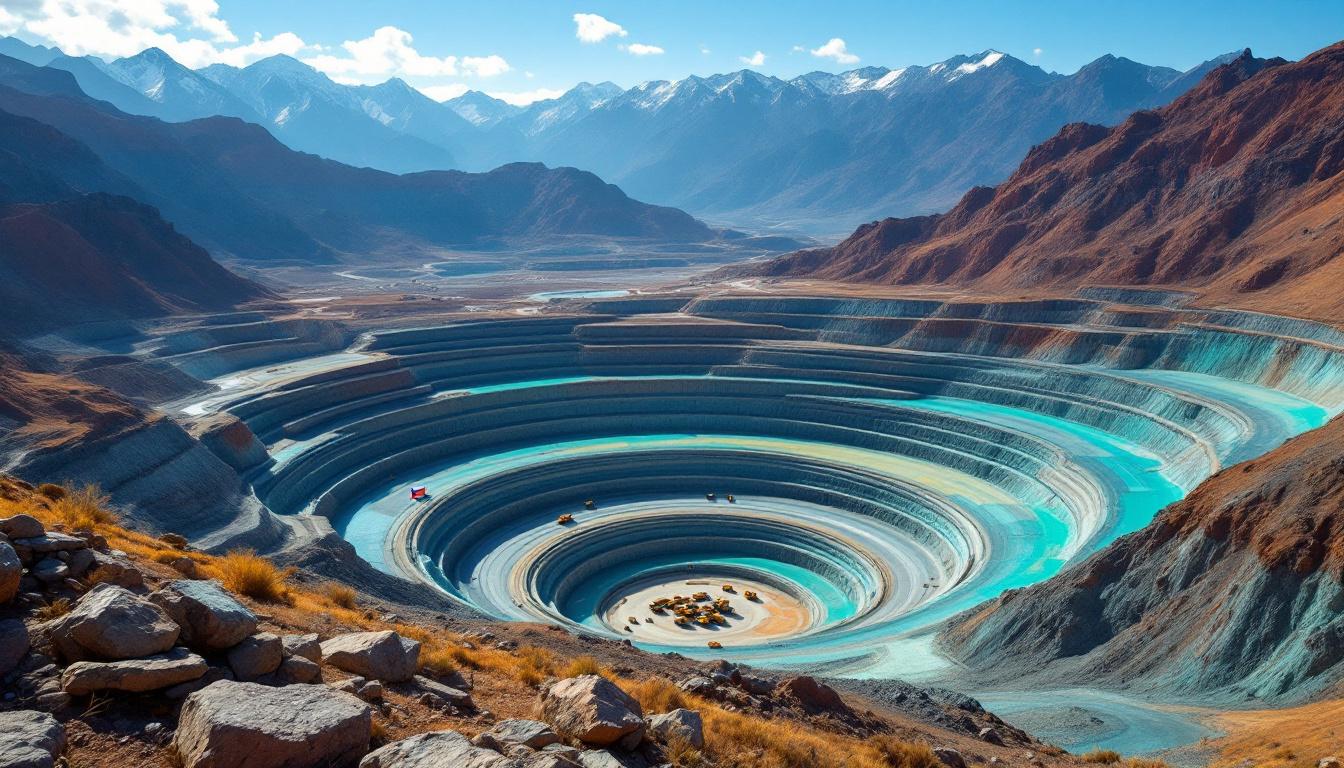How Did Codelco Reclaim Its Position as the World's Top Copper Producer?
Codelco's Production Milestone
Codelco's 2024 output of 1.44 million tons of copper marks a significant recovery from previous years, edging out competitors like BHP to reclaim the top producer title. This achievement underscores the company's historical significance as Chile's state-owned mining champion and reflects a concerted effort to address aging infrastructure and declining ore grades. The production rebound aligns with Chilean copper production trends and the broader economic strategy to leverage its natural resources, as copper accounts for approximately 10% of the nation's GDP.
Technological Innovations Driving Production
The company's resurgence is partly attributed to its adoption of advanced mining technologies, including automated drilling systems and real-time data analytics. These innovations have optimized extraction efficiency, reducing downtime and operational costs. Additionally, Codelco has prioritized mine rehabilitation projects, extending the lifespans of key assets like El Teniente and Chuquicamata. By integrating sustainable practices, such as water recycling systems and renewable energy adoption, the company has mitigated environmental impacts while maintaining output targets.
What Factors Are Influencing Current Copper Market Dynamics?
Record-Breaking Copper Prices
Copper futures surged to an all-time high of $11,840 per ton in early 2024, driven by supply shortages and speculative trading. Analysts project prices could exceed $12,000 per ton by year-end, reflecting heightened demand from renewable energy sectors and electric vehicle manufacturing. The copper price dynamics have been exacerbated by production disruptions in major mining regions, including labor strikes and regulatory challenges in Peru and Zambia.
Impact of Potential US Tariffs
Market volatility has intensified amid growing concerns over proposed US tariffs on copper imports. Such measures could destabilize global trade flows, particularly for Chile, which exports 30% of its copper to the United States. Historical precedents, like the 2018 aluminum tariffs, suggest that protectionist policies may incentivize supply chain diversification, with Chinese and European markets absorbing redirected shipments.
How Is the Global Copper Supply Chain Evolving?
Supply Tightening Trends
Global copper inventories have dwindled to 15-year lows, with Codelco and BHP collectively controlling nearly 25% of worldwide production. This consolidation has heightened market sensitivity to operational disruptions, as seen during the 2023 drought in Chile's Atacama region, which reduced output by 12%. Long-term forecasts indicate a structural supply deficit, with demand outpacing production by 8 million tons annually by 2030, according to the global copper market outlook.
State-Owned vs. Private Mining Operations
Codelco's state-owned structure provides strategic advantages, including government-backed financing and political support for expansion projects. However, private rivals like BHP and Freeport-McMoRan benefit from greater operational flexibility and access to international capital markets. Comparative analysis reveals that state-owned enterprises (SOEs) allocate 15% more of their budgets to community development programs, fostering local stakeholder engagement.
What Are the Investment Implications of Codelco's Production Leadership?
Market Outlook for Copper in 2024-2025
Copper's critical role in decarbonization technologies positions it as a high-growth commodity, with analysts forecasting a 7% annual demand increase through 2030. Investors are monitoring Codelco's ability to sustain production growth amid geopolitical risks, particularly China's dominance in refining capacity and Chile's regulatory reforms. ESG-focused funds are increasingly prioritizing copper due to its renewable energy applications, though concerns over water usage and indigenous land rights persist.
Strategic Importance of Chilean Copper
Chile's copper exports generated $40 billion in revenue in 2024, underscoring the metal's centrality to the national economy. Codelco's operations directly employ over 70,000 workers, contributing to regional economic stability. Geopolitically, Chile's alliances with European and Asian markets buffer against US trade policy shifts, though reliance on Chinese investment in mining infrastructure remains a contentious issue.
FAQ About Codelco and Copper Production
What Rehabilitation Methods Is Codelco Implementing to Extend Mine Life?
Codelco employs bioleaching techniques to extract copper from low-grade ores, reducing waste and extending mine viability. The company has also invested $1.2 billion in tailings management systems to prevent environmental contamination, aligning with global sustainability standards.
How Do US Tariffs Specifically Impact Global Copper Markets?
US tariffs could increase domestic copper prices by 20%, incentivizing recycling and secondary production. However, such measures risk triggering retaliatory tariffs from producing nations, potentially fragmenting global trade networks.
What Technological Innovations Are Transforming Copper Mining?
Autonomous haul trucks and AI-driven predictive maintenance systems have reduced Codelco's operational costs by 18% since 2022. The company is also piloting hydrogen-powered smelters, aiming to cut carbon emissions by 50% by 2030.
Geological Factors Affecting Codelco's Production
Declining Ore Grades and Technological Solutions
Codelco faces the industry-wide challenge of declining ore grades, with copper content in their deposits averaging 0.7% compared to historical levels of 1.2%. This necessitates processing more material to extract the same amount of copper. The company has pioneered new concentration methods that efficiently process lower-grade ores while minimizing water usage, a critical consideration in Chile's arid mining regions.
Depth and Accessibility Challenges
Many of Codelco's most productive mines are now operating at depths exceeding 1,000 meters, creating significant ventilation, stability, and transportation challenges. The company's investments in underground infrastructure, including the $5.6 billion Chuquicamata underground project, demonstrate their commitment to accessing deeper reserves despite geological complexities, as reported by Mining.com.
Regulatory and Environmental Considerations
Water Management in Copper Production
Water scarcity represents one of the most pressing challenges for Codelco's operations, especially in northern Chile's Atacama Desert. The company has achieved a 70% water recycling rate across its operations and is investing in desalination plants to reduce dependence on freshwater sources. These initiatives not only address environmental concerns but also mitigate production risks associated with drought conditions.
Environmental Compliance and Social License
Codelco operates under increasingly stringent environmental regulations that impact production timelines and costs. The company's recent commitment to reducing carbon emissions by 70% by 2030 requires significant operational adjustments and capital investments. Maintaining community support through transparent environmental practices has become essential to avoiding costly production disruptions due to social unrest or regulatory interventions.
Conclusion: The Future of Codelco and Global Copper Markets
Codelco's reclamation of its position as the world's leading copper producer reflects its strategic adaptation to evolving market conditions, technological innovation, and commitment to sustainable practices. As global demand for copper continues to surge, driven by renewable energy transitions and electrification, Codelco's ability to manage geological challenges, regulatory requirements, and international trade dynamics will determine its long-term success. For investors and industry observers, Codelco serves as a barometer for broader copper smelting insights and Rio Tinto's copper strategy, highlighting the complex interplay between state ownership, technological advancement, and environmental stewardship in modern mining operations.
Looking to Spot the Next Major Copper Discovery?
Discovery Alert's proprietary Discovery IQ model delivers instant notifications when significant copper discoveries are announced on the ASX, helping investors capitalise on opportunities before the broader market responds. Explore how major mineral discoveries have historically generated substantial returns by visiting Discovery Alert's dedicated discoveries page and position yourself for success in the dynamic copper market.




